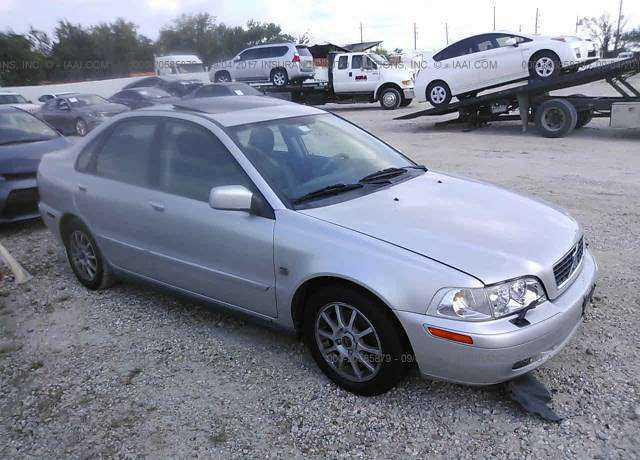 "Cé hé sin" (michael-m-mouse)
"Cé hé sin" (michael-m-mouse)
03/30/2019 at 12:01 • Filed to: Dead cars
 0
0
 12
12
 "Cé hé sin" (michael-m-mouse)
"Cé hé sin" (michael-m-mouse)
03/30/2019 at 12:01 • Filed to: Dead cars |  0 0
|  12 12 |
Peugeot 206, Hyundai Getz , Daewoo something, Alfa 156, Volvo S 4 0. Judging by the flatness of their tyres none of these are going anywhere except the tin can trade.

 bob and john
> Cé hé sin
bob and john
> Cé hé sin
03/30/2019 at 12:19 |
|
S40* the V was the wagon.
shame, my mom had one of those. good car.
 jimz
> Cé hé sin
jimz
> Cé hé sin
03/30/2019 at 12:20 |
|
Whatever you need, Leo Getz!

 fhrblig
> Cé hé sin
fhrblig
> Cé hé sin
03/30/2019 at 12:20 |
|
That’s not a Hyundai Getz, it’s a Chevy Aveo or Daewoo Kalos. (Not that it matters that much, I just enjoy being pedantic.)
What makes me laugh is that there are cars in my condo parking lot that are nowhere near in as good of shape as these four cars.
 Cé hé sin
> fhrblig
Cé hé sin
> fhrblig
03/30/2019 at 12:24 |
|
Yes, I’m endlessly surprised by the kind of car I see disposed of. Many of them are newer than mine and superficially seem fine.
I can never tell
all those small and Eastern hatches apart.
 bhtooefr
> fhrblig
bhtooefr
> fhrblig
03/30/2019 at 12:26 |
|
I think the big thing is that more mechanical complexity means that powertrain failures are too costly to be worth fixing there, whereas here, the simpler powertrains survive, and it’s crash damage and rust that take our cars out.
Also, large swaths of the US without safety or emissions inspections probably contributes, too.
 dogisbadob
> Cé hé sin
dogisbadob
> Cé hé sin
03/30/2019 at 12:50 |
|
I like that Echo hatch in the background ;)
Nice first-gen S40 and Aveo
 WilliamsSW
> Cé hé sin
WilliamsSW
> Cé hé sin
03/30/2019 at 13:40 |
|
Those look too nice to be recycled.
Must be the value of all that silver driving the scrap value up :)
 Cé hé sin
> dogisbadob
Cé hé sin
> dogisbadob
03/30/2019 at 16:31 |
|
Er....Yaris!
 Cé hé sin
> bhtooefr
Cé hé sin
> bhtooefr
03/30/2019 at 18:48 |
|
I’d have thought powertrains would be more complex over there, with more emissions equipment and usually automatic gearboxes.
But yes, annual testing becomes too expensive to pass when the car reaches a point where it’s worth very little.
 facw
> Cé hé sin
facw
> Cé hé sin
03/30/2019 at 19:05 |
|
I miss my S40. I think mine looked nicer though, even if that one weren’t dented.
I’m fairly sure i t’s already gone to meet its maker:

 bhtooefr
> Cé hé sin
bhtooefr
> Cé hé sin
03/30/2019 at 19:19 |
|
Automatics do increase complexity and have their own failure rate, but they also remove some classes of operator misuse failure.
So, one thing to keep in mind in the US is that... as much as we complain about fuel prices, fuel is dirt cheap compared to most of the rest of the world. And, “emissions” doesn’t include CO2 - it’s non-methane organic gases, nitrogen oxides, particulate matter, carbon monoxide, and formaldehyde that are the regulated tailpipe emissions from cars. Additionally, evaporative emissions from the fuel are a concern.
This means that “meeting emissions” means completely burning your fuel at all costs, even if you just turn it into heat.
So, the formula for meeting emissions in the US has, historically, been:
Start with a big engine - big enough to have adequate performance at low to moderate RPM (think 2000-3000 RPM) while naturally aspirated, to work well with primitive automatics, while being cheap to produce.
You don’t need to get fancy with the fuel injection, port injection is fine, you’re just aiming for stoichiometric mixture in all cylinders. This way, you minimize excess oxygen that could react to produce nitrogen oxides.
Whatever does come out of the headers, the catalytic converters will burn up quite nicely.
Then, you just need to have the fuel system such that evaporative emissions are trapped.
Note that the resulting engine won’t be particularly efficient . If you care about that, you can do things to cut down on friction, maybe add EGR (often through exhaust valve timing) to reduce pumping losses, that kind of thing. But, that costs money, and when customers won’t pay for fuel economy, you don’t bother with it. And, typically, this engine will be pretty trouble-free, and if it breaks, it’s cheap enough that you can replace the whole engine for what a subsystem repair costs on a European engine.
The European approach seems to be to throw technology at the problem, to try to extract every little bit of thermal efficiency possible (sometimes only theoretical), at any cost, even if there’s cascading negative effects from trying to bring the emissions into check (or just from pretending to, as with the diesels).
Granted, ever since CAFE increases came about in the US, the typically conservative American and the more conservative of the Japanese automakers have jumped on some of this technology, too, with varying reliability impacts...
(Myself, if you’re going to have an engine, I like some of Toyota’s approaches - turns out just executing a good moderate to large displacement low-friction design, and then giving it late intake valve closing and high compression pistons, gets you good efficiency, both theoretical and in the real world, with a relatively simple engine design. My Prius’s engine has a technology level that would’ve last been considered “modern” in about the late 1990s, at least as far as a checklist of features would go, but it pulls out 40% thermal efficiency, just through gradual refinement of the old tech. Add direct injection, and Toyota’s new engine family hits 41% in the late intake valve closing variants. )
 pip bip - choose Corrour
> Cé hé sin
pip bip - choose Corrour
> Cé hé sin
03/30/2019 at 23:45 |
|
Daewoo Kalos/Chevy Aveo/Holden Barina